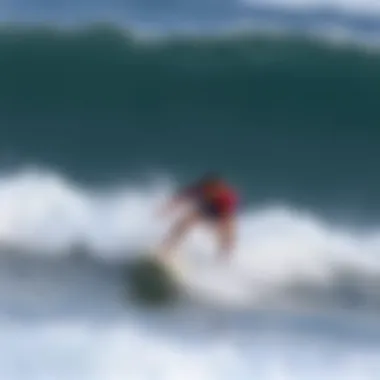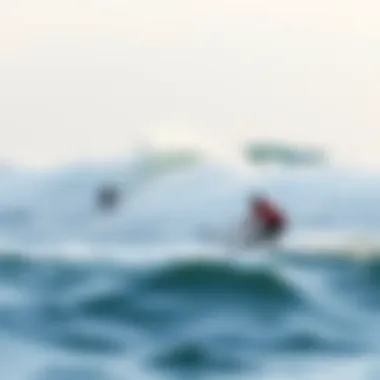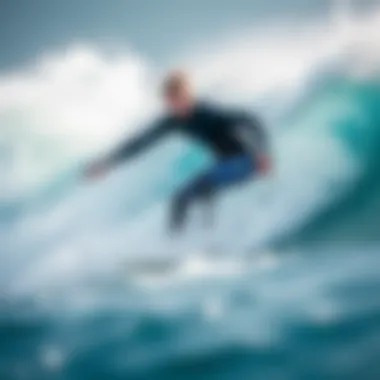Selecting the Most Effective Surf Forecast Apps


Intro
Surfing is more than just a sport; it’s a way of life that connects enthusiasts across the globe. With the right tools at hand, surfers can elevate their experiences, making each session on the water more meaningful. This is where surf forecast apps come into play. They not only inform surfers about wave conditions but also empower them with the knowledge to choose the best times for riding the waves. In this article, we’ll dissect the key elements of surf forecast apps, exploring their features, benefits, and limitations. With detailed analysis, we aim to inform both new and experienced surfers on how to best utilize these apps for optimal surfing adventures.
Whether you are a weekend warrior or a seasoned pro, understanding the ins and outs of these applications can make the difference between a mediocre surf session and an unforgettable ride. Since the essence of surfing hinges on timing and conditions, having access to reliable predictions can drastically enhance your surfing journey. The article navigates through various aspects critical to selecting an app that suits your needs, guiding you through the oceans of information that can feel overwhelming at times.
Continue with us as we delve into essential surfing techniques and explore the lifestyle surrounding this exhilarating sport.
Prelude to Surf Forecast Apps
Surfing is more than just a sport; it’s an experience that intertwines with nature, adrenaline, and community. For both enthusiasts and seasoned professionals, having access to reliable surf forecast apps can make the difference between a mediocre day on the waves and an unforgettable session. These applications serve as lifelines to surfers, translating complex meteorological data into actionable intel that enables them to be at the right place at the right time.
The Importance of Accurate Surf Forecasting
Accurate surf forecasting isn't merely about predicting wave heights or swell periods. It encompasses a multitude of factors that influence the quality of surf on any given day. Wind direction, tide levels, and weather systems all play a significant role in determining whether surfers can ride the waves safely and enjoyably.
"A good surf app is like having a seasoned coach in your pocket, guiding you through the uncertainties of the ocean."
Imagine heading out to catch some waves, only to find that conditions are far from ideal. This frustration can be easily avoided with accurate and timely forecasts provided by specialized apps. They help surfers plan their outings efficiently, minimizing wasted trips and maximizing the thrill of surf riding. With accurate data, surfers can make informed choices about which spots to target, helping them avoid crowded beaches and subpar conditions.
How Surf Forecast Apps Have Evolved
The evolution of surf forecast apps is fascinating. Initially, surfers relied heavily on word-of-mouth and basic online forecasts provided by local surf shops or news stations. However, advancements in technology have transformed how surfers gather information. From simple web-based resources to sophisticated mobile applications, the landscape has drastically shifted. Today, these apps incorporate real-time satellite data, user-generated reports, and community feedback to present a vivid picture of ocean conditions.
Surfers can now access detailed graphs and models that predict not just surf height, but also factors such as wind speed, precipitation, and even air temperature. Many apps have embraced social features, allowing surfers to share conditions with their peers, fostering a sense of community amidst the waves.
The continuous innovation in surf forecasting technology demonstrates the growing importance of precise information in enhancing the surfing experience. As surfer preferences evolve, app developers face the challenge of keeping their offerings relevant and comprehensive, thus ensuring that the community remains well-informed and engaged.
This transition from rudimentary forecasting methods to sleek, user-friendly applications reflects a larger trend in the sports technology landscape, marrying passion with cutting-edge technology. With the right surf forecast app, surfers not only gain insight but also form a deeper connection with the ocean.
Criteria for Evaluation
Forecast Accuracy and Reliability
First on the list is forecast accuracy and reliability. It's paramount that surfers can trust the information they receive. After all, one misleading forecast can lead surfers into dangerous conditions or leave them standing at the shore when the swell is right. The accuracy stems from the data sources used by an app—whether they rely on local buoys, weather satellites, or ocean weather models, the app needs to display current and trustworthy info. A reliable app not only makes forecasts but also updates them in real-time, providing surfers with the confidence to plan their surf days properly.
User Experience and Interface
Next, we examine user experience and interface. A confusing interface can put surfers off, even if the app has great forecasts. Seamless navigation is key; everything from checking the weather to looking up recommendations should feel natural. For instance, consider how quickly you can get to the surf report when you're eager to hit the waves. Applications that prioritize usability often have interactive designs, allowing surfers to swipe through reports or highlight favorite spots. This leads to more frequent and engaged use, directly impacting the enjoyment of the surfing experience.
Additional Features and Tools
Beyond just forecasts, many apps come with additional features and tools that can enhance the user experience. These features can range from community outreach programs to elaborate wave models.
Community Features
A significant aspect of Community Features is their ability to connect surfers. Many apps incorporate social functions, offering forums or user-generated content where surfers can share local insights or even post conditions at various spots in real-time. This creates a sense of camaraderie among surfers, no matter their skill level. Moreover, the ability to communicate with others can lead to discovering new surf spots or receiving tips that might not be readily available through conventional channels. However, it's essential to ensure that such community-driven platforms remain constructive while avoiding misinformation.


Wave Models
Then there’s the intriguing subject of Wave Models. These models predict wave height, period, and direction based on complex algorithms. They are particularly favored by competitive surfers who thrive on precision and detail. With good wave models, surfers can make informed decisions about when and where to surf, maximizing their experience. However, these models can get tricky; some might offer interpretations that vary significantly depending on their data sources. Those discrepancies can frustrate users who rely on accurate predictions to plan their days.
Surf Spot Information
Lastly, Surf Spot Information is a crucial feature. Detailed insights about specific locations—like tide changes, cultural tips, and potential hazards—inform surfers about what to expect when they arrive. This feature is especially helpful for travelers looking to explore unfamiliar beaches. An excellent surf forecast app should allow users to access this information easily, ideally featuring photographs or reviews to set realistic expectations. However, excessive clutter in this section can overwhelm users, leading to confusion instead of clarity.
Together, these criteria form the backbone of a solid surf forecast app evaluation. By focusing on forecast accuracy, user interface, and additional features, surfers can choose the apps that best meet their needs, ensuring an enriched and safe surfing experience.
Top Surf Forecast Apps Reviewed
Evaluating surf forecast apps is vital not just for pros but also for casual surfers looking to maximize their time in the water. With the immense variety of apps available, it can be tough to sift through the noise. This section dives deep into three noteworthy applications that cater specifically to the needs of surfers. By unpacking their features, performance, and user feedback, we provide a comprehensive understanding of what these apps offer and how they shape the surfing experience.
App One: Comprehensive Overview
Features
When talking about app features, let’s not gloss over the essential tools like real-time wave height, wind speed, and tide times. App One excels in offering a user-friendly interface that displays all this information in a straightforward manner. One standout feature includes the ability to customize notifications based on your preferred surf conditions, so users don’t miss the perfect swell. However, while this feature enhances user engagement, there’s a slight hiccup; some users have reported short delays in notifications, which could cause a bit of frustration during peak surf times.
Performance Analysis
In terms of performance, App One boasts a high degree of accuracy which has been consistently lauded by its user base. The data updates frequently, ensuring that all information is current when it comes to potential surfing conditions. The model blending technology utilized helps in delivering precise forecasts. Still, some surfers have noted occasional discrepancies with actual surf conditions, particularly in unpredictable weather. Nonetheless, its reliability has garnered a solid reputation among users.
User Feedback
User feedback on App One is largely positive, with many remarks highlighting its intuitive interface and robust forecasting capabilities. More experienced surfers have especially appreciated the detailed analytics provided for each surf spot, making it a valuable resource for serious enthusiasts. There are minor complaints regarding the interface speed, but the general consensus is that the app's value significantly overshadows these concerns. Users often refer to it as a “must-have” in their surf gear lineup.
App Two: Comprehensive Overview
Features
Moving to App Two, it offers a differing array of features that cater to both novice and experienced surfers. Its standout characteristic is the community aspect which allows users to share local conditions and photo updates. This real-time sharing makes it a lively platform for enthusiasts who enjoy social interaction. However, the crowded interface can be overwhelming for some, making it challenging to find specific features quickly when time is of the essence.
Performance Analysis
App Two showcases an impressive performance level with forecasts that are generally spot-on. The app leverages innovative algorithms to predict wave patterns, granting it a high mark for accuracy. Reviews suggest that its predictions are particularly reliable in coastal areas known for being unpredictable. Nevertheless, a few users expressed concerns over its tendency to overestimate wave heights during certain seasons, which may lead to mismatched expectations.
User Feedback
The feedback generated for App Two is a mixed bag. While many users praise its interactive platform and community feel, others lament the cluttered presentation of information. Many recommend this app in tandem with a more straightforward forecasting tool as it can bridge gaps in local surf knowledge, especially in unfamiliar territories.
App Three: Comprehensive Overview
Features
App Three stands out for its streamlined approach to surf forecasting. It focuses heavily on wave analysis and conditions without frills, making it particularly popular among data-driven surfers. One of its unique features is a detailed timeline visual that shows expected wave heights and periods over the day. On the flip side, the lack of community features may make it feel a bit isolated for those who thrive on social interaction in the surf world.


Performance Analysis
Concerning performance, App Three has showed promise with its high-grade wave models that outperform average predictions when swells are in play. Its analytical tools are well-respected, particularly amongst competitive surfers who rely on precise conditions. Some have pointed out, however, that the app does sometimes struggle to predict conditions accurately in spots with less historical data, resulting in inconsistent experiences.
User Feedback
User feedback for App Three often highlights its effectiveness for serious surfers and those who appreciate straightforward data. Many have voiced their admiration for its precision, making it a go-to choice for experienced riders. One downside mentioned is that newcomers might find it lacking in user support and tutorials that can help them get accustomed to reading radar data. Overall, it holds a stable position in the community, particularly among those who prioritize performance over social engagement.
In the dynamic world of surfing, having the right tools at your fingertips can make all the difference in your experience. Evaluating different apps caters to various user needs, allowing everyone from casual wave-riders to competitive athletes to find their preferred platform.
Comparative Analysis of Leading Apps
In an arena as dynamic as surfing, where conditions can shift in the blink of an eye, having a reliable surf forecast app becomes not just a luxury, but a necessity. This section embarks on a comparative analysis of leading surf forecast apps, scrutinizing their features to help surfers make an informed choice. By understanding the strengths and weaknesses of each application, individuals can select the tool that best complements their surfing style and preferences.
Strengths and Weaknesses
Evaluating the strengths and weaknesses of surf forecast apps is akin to sifting through seawater to find pearls. Each app brings its unique flavor to the table, but not all shine equally bright. Here, we break down some common strengths:
- Accurate and Timely Forecasts: Some apps rely on cutting-edge technology to provide real-time updates. For instance, applications like Windy or Magicseaweed often utilize advanced predictive models that help surfers catch those perfect waves.
- User-Friendly Interface: An app that's easy to navigate can significantly enhance the user experience. Apps like Surfline pride themselves on their intuitive designs, making them accessible even to those who might find technology daunting.
- Rich Community Features: Many surfers appreciate apps that offer community-driven insights. Applications such as Surfline not only deliver forecasts but also gather local reports, which can offer a boots-on-the-ground perspective.
However, despite these strengths, there are also common weaknesses, such as:
- Inconsistency in Forecasting: Some apps might have trouble maintaining accuracy, particularly in regions with rapidly changing conditions. Issues can arise where the forecasts are right one day and misleading the next.
- Equipment Demand: Certain apps may require users to invest in additional equipment for the best experience, which could deter those who are new to surfing.
- Subscription Fees: While many apps offer free services, the top-notch features often come with a price, potentially alienating budget-conscious surfers.
User Preferences Across Different Regions
The world of surfing is as diverse as the coastlines it thrives on. When analyzing user preferences across different regions, it becomes evident that geographical nuances play a significant role in what surfers value in an app. For example:
- Tropical Regions: Surfers in places like Bali or Hawaii might prioritize wave size predictions and wind patterns. They often favor apps that provide hyper-local forecasts tailored to their favorite surf spots.
- Cold Water Surfing: In regions like California's coast or the chilly waves of Cornwall, users are more inclined to consider water temperature forecasts and swell direction, as these elements can drastically affect the comfort and safety of a surfing session.
- Regional Communities: Substantial regional differences exist regarding community insights. In places with close-knit surfing communities, like those in Australia or South Africa, there’s a collective preference for apps that also integrate social features. This could mean user-generated reports of surf conditions or community boards where surfers can share experiences.
At the end of the day, choosing the right surf forecast app requires personal touches and a bit of trial and error. By understanding these strengths and regional preferences, surfers can find an app that fits their unique surfing needs.
"A reliable surf forecast app is like having a seasoned local in your pocket, ready to guide you to the best waves, every time."
For further insights on surf conditions and forecasts, consider checking resources like Wikipedia and Surfline to get an even broader perspective.
The Role of Technology in Surf Forecasting
The role of technology in surf forecasting can't be overstated; it's fundamentally reshaped how surfers approach their passion. Gone are the days when one relied solely on gut feeling or questionable local wisdom. Now, armed with smartphones and powerful applications, surfers can access refined data to assess wave conditions, wind patterns, and tides with remarkable precision. With such advancements, the fishing net of uncertainty has been cast aside to a great extent, but it raises questions about how much we can truly rely on tech in connection to the natural world.
By utilizing advanced forecasting models, these applications allow users to make educated decisions about when and where to hit the waves. The nuances of surf forecasting hinge on both meteorological sciences and cutting-edge algorithms, making it an area of interest for not only surfers but also data enthusiasts and environmental scientists.
Advancements in Meteorological Science
The landscape of meteorological science has grown leaps and bounds in recent years, mirroring the sophistication inherent in surf forecasting technologies. Models today utilize a variety of data sources, ranging from satellite imagery to buoy readings, providing a more robust foundation for forecasts. For instance, the integration of Doppler radar and remote sensing enables surfers to anticipate storm systems and their aftermath, essential for pinpointing the best surf opportunities.
Moreover, the innovations in data analytics allow for real-time interpretation of complex atmospheric phenomena. This means that not only are surfers privy to daily predictions, but they also receive regular updates as conditions change, offering a near-live insight into surf potential. Such advancements are a boon for both recreational surfers and those with professional stakes in the sport.


The Impact of Machine Learning and AI
When it comes to pushing boundaries in surf forecasting, machine learning and artificial intelligence represent a significant leap forward. These technologies empower surf forecast apps to analyze vast datasets and recognize patterns that human forecasters might miss. As the algorithms churn through historical data, they can provide customized predictions base on user preferences and local conditions.
For example, imagine a surfer using an app that learns which types of surf conditions they prefer based on previous outings. The app becomes more accurate by predicting conditions tailored to that individual’s style or skill level, all thanks to AI. This results in a leap from generic predictions to targeted, highly relevant data.
"The confluence of machine learning and meteorological data transforms how we interact with nature, enhancing our enjoyment and safety while surfing."
Yet, while these technologies offer tremendous benefits, it's essential for users to remain aware of their limitations as well. While AI can optimize data interpretations, it's not infallible; unexpected variables like local weather quirks wouldn’t always align with models based on broader data sets.
The intersection of technology and surf culture is a fascinating field that continues to evolve as new tools emerge. From improved accuracy in forecasts to personalized surfing advice, technology undoubtedly plays an essential role in enhancing the surf experience. As we look towards the future, keeping an eye on these developments may make for smoother rides and a safer ocean adventure.
User Recommendations and Expert Opinions
The value of user recommendations and expert opinions in evaluating surf forecast apps cannot be overstated. Recommendations from those who actively engage in surfing or have expertise in meteorology often bring a practical perspective that transcends the scope of technical specifications. These insights play a pivotal role in understanding how various apps perform in real-world scenarios.
Expert Insights on Surf Forecasting
Experts in surf forecasting encompass a diverse group, including meteorologists, seasoned surfers, and developers of forecasting technologies. Their insights can help demystify the intricacies of surf forecasts by breaking down complex data into easily digestible morsels.
- Meteorological Expertise: Professional meteorologists can provide clarity on how weather patterns, tides, and wind conditions converge to affect surf quality. Their perspectives help users discern subtleties in forecasting that casual surfers might miss.
- Seasoned Surfer Feedback: Many experts are also experienced surfers who understand the nuances of what makes a surf day great. They can recommend apps based on their own surfing habits and needs. For instance, they might emphasize features like real-time alerts or detailed swell charts.
- Technology Developers: Insights from developers who create these forecasting tools can highlight the innovative algorithms or data sources that drive an app's accuracy. Such transparency can build trust and help potential users make informed choices.
Ultimately, seeking expert opinions allows for a more nuanced understanding of surf forecasting technologies beyond mere app features. This broad perspective adds credibility to evaluations and aids users in selecting an app suited to their specific surfing lifestyle and needs.
User Testimonials and Experiences
User testimonials bring a grassroots perspective to how these surf forecast apps perform in the wild. Lessons learned through firsthand experiences can guide others in making informed decisions. Considerations from regular users often highlight strengths and weaknesses that formal reviews gloss over.
- Diverse Conditions: Different surfers operate in various conditions. A user who regularly surfs on the East Coast might find a particular app more reliable compared to someone on the West Coast. Users often recount their experiences in forums or social media, discussing how accurate the forecasts were compared to their actual surf days.
- Usability Feedback: User experiences often touch upon the app’s interface, ease of navigation, and overall design. For instance, a surfer might say, "I appreciate how intuitive it is to access the tide charts within the app, making it easier for me to plan my trips."
- Community Dynamics: Many apps incorporate user feedback systems or community features, allowing surfers to share conditions or tips. This interaction fosters a sense of camaraderie and helps refine the accuracy of localized forecasts.
Testimonial influence is especially strong in today's digital space. For example, platforms like Reddit and Facebook provide surfers with a community to share experiences. A user might post, "After trying out Surfline, I finally felt I was in tune with nature, following swells as they rolled in right outside my doorstep."
Closure and Future Trends
As we round off the talk on surf forecast apps, it’s essential to recognize how crucial these tools have become for surfers today. Gone are the days when surfers relied solely on gut feelings or hearsay about wave conditions. Now, surfers, whether seasoned pros or newbies, have access to invaluable data right at their fingertips. Understanding the trends and future developments in surf forecasting technology isn't just about staying ahead of the curve; it's about enhancing the entire surfing experience.
Looking Ahead in Surf Forecasting Technology
The surf forecasting tools we utilize today are already sophisticated, but the roadmap ahead is paved with potential innovations. One of the most exciting developments is the integration of real-time data collection. With advancements in satellite technology, we can expect more localized and accurate surf conditions. For instance, drones have already started to play a role in capturing current wave patterns and currents accurately. Imagine hovering over your favorite surf spot, getting live updates about water conditions and tide changes. This leap isn’t far-fetched.
Moreover, machine learning is steadily creeping into our surf apps, fine-tuning predictions based on historical data. It’s not merely about analyzing trends; it's about predicting the unpredictable. By analyzing factors like wind speeds, water temperatures, and even local weather patterns, future apps could offer tailored forecasts, helping each surfer make the most informed decisions possible.
The Future of Surf Culture and Technology
The relationship between surfing and technology is evolving, with each bolstering the other. Surf culture thrives on community and shared experiences, which technology is amplifying. Platforms that offer connectivity among surfers, like Facebook groups or Reddit forums, create a sense of camaraderie and provide valuable shared insights. Additionally, as sustainability takes a front seat, surf brands are harnessing technology to develop eco-friendly products and practices, attracting a more conscious surfing community.
The idea of merging surf technology with environmental stewardship is not just a trend; it's a necessity. Future innovations in surf forecasting can also leverage artificial intelligence to analyze the impact of climate change on surfing conditions. Adapting to these changes will keep surf culture vibrant and relevant.
In essence, as surf forecasting apps continue to evolve, so too will the culture surrounding them. Surfers who embrace these advancements will find themselves better informed, more connected, and ultimately, able to enjoy their passion to the fullest.
“The ocean is a canvas and surf forecasting tools are the brushes. The future is bright for those willing to adapt.”
Stay tuned in this space, as it promises not just waves, but a wave of innovative technologies that will shape how we experience the ocean.















